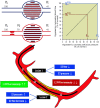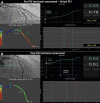Coronary physiology in the catheterisation laboratory: an A to Z practical guide
- PMID: 36798834
- PMCID: PMC9890586
- DOI: 10.4244/AIJ-D-22-00022
Coronary physiology in the catheterisation laboratory: an A to Z practical guide
Abstract
Coronary revascularisation, either percutaneous or surgical, aims to improve coronary flow and relieve myocardial ischaemia. The decision-making process in patients with coronary artery disease (CAD) remains largely based on invasive coronary angiography (ICA), even though until recently ICA could not assess the functional significance of coronary artery stenoses. Invasive wire-based approaches for physiological evaluations were developed to properly assess the ischaemic relevance of epicardial CAD. Fractional flow reserve (FFR) and later, instantaneous wave-free ratio (iFR), were shown to improve clinical outcomes in several patient subsets when used for coronary revascularisation guidance or deferral and for procedural optimisation of percutaneous coronary intervention (PCI) results. Despite accumulating evidence and positive guideline recommendations, the adoption of invasive physiology has remained quite low, mainly due to technical and economic issues as well as to operator-resistance to change. Coronary image-based computational physiology has been recently developed, with promising results in terms of accuracy and a reduction in computational time, costs, radiation exposure and risks for the patient. Lastly, the integration of intracoronary imaging and physiology allows for individualised PCI treatment, aiming at complete relief of ischaemia through optimised morpho-functional immediate procedural results. Instead of a conventional state-of-the-art review, this A to Z dictionary attempts to provide a practical guide for the application of coronary physiology in the catheterisation laboratory, exploring several methods, their pitfalls, and useful tips and tricks.
Conflict of interest statement
W. Wijns received a research grant and honoraria from MicroPort (TARGET AC trial); is the co-founder of Argonauts, an innovation facilitator; and is the senior medical advisor at Rede Optimus Research and Corrib Core Laboratory. S. Tu is a consultant for and received research grants from Pulse Medical. The other authors have no conflicts of interest to declare.
Figures



















Similar articles
-
Role of physiology in the management of multivessel disease among patients with acute coronary syndrome.AsiaIntervention. 2024 Sep 27;10(3):157-168. doi: 10.4244/AIJ-D-24-00051. eCollection 2024 Sep. AsiaIntervention. 2024. PMID: 39347110 Free PMC article. Review.
-
Fractional flow reserve in clinical practice: from wire-based invasive measurement to image-based computation.Eur Heart J. 2020 Sep 7;41(34):3271-3279. doi: 10.1093/eurheartj/ehz918. Eur Heart J. 2020. PMID: 31886479
-
The Impact of Coronary Physiology on Contemporary Clinical Decision Making.JACC Cardiovasc Interv. 2020 Jul 27;13(14):1617-1638. doi: 10.1016/j.jcin.2020.04.040. JACC Cardiovasc Interv. 2020. PMID: 32703589 Review.
-
Immediate impact of coronary artery bypass graft surgery on regional myocardial perfusion: Results from the Collaborative Pilot Study to Determine the Correlation Between Intraoperative Observations Using Spy Near-Infrared Imaging and Cardiac Catheterization Laboratory Physiological Assessment of Lesion Severity.JTCVS Open. 2022 Sep 13;12:158-176. doi: 10.1016/j.xjon.2022.08.012. eCollection 2022 Dec. JTCVS Open. 2022. PMID: 36590739 Free PMC article.
-
Diagnostic Agreement of Quantitative Flow Ratio With Fractional Flow Reserve and Instantaneous Wave-Free Ratio.J Am Heart Assoc. 2019 Apr 16;8(8):e011605. doi: 10.1161/JAHA.118.011605. J Am Heart Assoc. 2019. PMID: 30977410 Free PMC article.
Cited by
-
Angiography-derived index of microvascular resistance in takotsubo syndrome.Int J Cardiovasc Imaging. 2023 Jan;39(1):233-244. doi: 10.1007/s10554-022-02698-6. Epub 2022 Nov 7. Int J Cardiovasc Imaging. 2023. PMID: 36336756 Free PMC article.
-
Illusion of revascularization: does anyone achieve optimal revascularization during percutaneous coronary intervention?Nat Rev Cardiol. 2024 Sep;21(9):652-662. doi: 10.1038/s41569-024-01014-0. Epub 2024 May 7. Nat Rev Cardiol. 2024. PMID: 38710772 Review.
-
Practical Application of Coronary Physiologic Assessment: Asia-Pacific Expert Consensus Document: Part 1.JACC Asia. 2023 Aug 29;3(5):689-706. doi: 10.1016/j.jacasi.2023.07.003. eCollection 2023 Oct. JACC Asia. 2023. PMID: 38095005 Free PMC article. Review.
-
Validation of machine learning angiography-derived physiological pattern of coronary artery disease.Eur Heart J Digit Health. 2025 Apr 8;6(4):577-586. doi: 10.1093/ehjdh/ztaf031. eCollection 2025 Jul. Eur Heart J Digit Health. 2025. PMID: 40703120 Free PMC article.
-
In Vivo Validation of a Novel Computational Approach to Assess Microcirculatory Resistance Based on a Single Angiographic View.J Pers Med. 2022 Oct 31;12(11):1798. doi: 10.3390/jpm12111798. J Pers Med. 2022. PMID: 36573725 Free PMC article.
References
-
- Brueren BR, ten Berg, Suttorp MJ, Bal ET, Ernst JM, Mast EG, Plokker HW. How good are experienced cardiologists at predicting the hemodynamic severity of coronary stenoses when taking fractional flow reserve as the gold standard. Int J Cardiovasc Imaging. 2002;18:73–6. - PubMed
-
- Tonino PA, Fearon WF, De Bruyne, Oldroyd KG, Leesar MA, Ver Lee, Maccarthy PA, Van’t Veer, Pijls NH. Angiographic versus functional severity of coronary artery stenoses in the FAME study fractional flow reserve versus angiography in multivessel evaluation. J Am Coll Cardiol. 2010;55:2816–21. - PubMed
-
- Adjedj J, Westra J, Ding D, Yang J, Wijns W, Tu S. Computational non-invasive physiological assessment of coronary disease. In The PCR - EAPCI Textbook Percutaneous Interventional Cardiovascular Medicine. 2021.
-
- Jüni P. PCI for Nonculprit Lesions in Patients with STEMI — No Role for FFR. N Engl J Med. 2021;385:370–1. - PubMed
-
- De Maria, Alkhalil M, Borlotti A, Wolfrum M, Gaughran L, Dall’Armellina E, Langrish JP, Lucking AJ, Choudhury RP, Kharbanda RK, Channon KM, Banning AP. Index of microcirculatory resistance-guided therapy with pressure-controlled intermittent coronary sinus occlusion improves coronary microvascular function and reduces infarct size in patients with ST-elevation myocardial infarction: the Oxford Acute Myocardial Infarction - Pressure-controlled Intermittent Coronary Sinus Occlusion study (OxAMI-PICSO study). EuroIntervention. 2018;14:e352–9. - PubMed
Publication types
LinkOut - more resources
Full Text Sources
Miscellaneous

